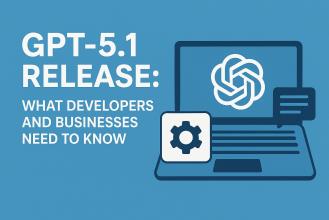How gpt-realtime & Realtime API Power Low-Latency Voice Agents
- 19 November, 2025 / by Fosbite
What is gpt-realtime and the Realtime API?
OpenAI’s gpt-realtime model combined with the Realtime API gives teams a practical, production-ready route to voice agents that actually feel conversational: low-latency speech-to-speech, reliable instruction-following, real-time function calling, SIP phone support, and even image-aware sessions. Having built a couple of prototypes with streaming audio, I’ll tell you — the payoff is responsiveness. Conversations stop sounding like a patchwork of speech-to-text and text-to-speech. The audio stays whole, and that subtle continuity matters.
Why this matters: latency, nuance, and unified audio
The truth is most voice stacks still glue together speech-to-text → LLM → text-to-speech. It works, sure, but you lose time and nuance. gpt-realtime processes audio more directly — effectively a speech-to-speech LLM — so round-trip latency drops and paralinguistic cues (pauses, emphasis) are preserved. That’s why it’s becoming the go-to for low-latency speech-to-speech AI in real deployments.
- Lower latency: Faster reply times make agents usable for phone calls and live assistants — not just demos.
- Preserved nuance: Prosody and timing stay intact, which helps with empathy and clarity.
- Simpler architecture: One pipeline instead of many — fewer integration points, fewer failure modes.
Audio quality, voices, and instruction-driven style
OpenAI ships tuned voices (Cedar, Marin, etc.) that will change pace and tone based on prompts. Tell the agent to "speak slow and empathetic" or "be concise and professional" and it will shift prosody and pacing. This is huge for customer support, healthcare triage, or any scenario where tone changes outcomes.
Quick anecdote: in a customer service prototype I ran, asking the agent to "apologize briefly, then propose next steps" produced a short, measured apology and then clear, task-oriented directives — much closer to how a human rep would answer than the usual flat TTS output. That’s a simple demonstration of instruction-driven voice and audio prosody control in action.
Stronger instruction following and conversational understanding
Benchmarks and practical testing show improved instruction following — the model better obeys system directives ("read this verbatim," "stay in character as a patient nurse") and interprets conversational signals like laughter or filler sounds. That lets the agent manage turn-taking more naturally, and even decide when to interrupt or hand off to a human.
Function calling and real-time tool integration
One standout capability is real-time function calling. During a live call, an agent can call APIs, fetch records, or kick off workflows without freezing the conversation. In practice you can run asynchronous calls while the agent narrates: "I’m pulling up your order now — this may take a few seconds," followed by a live update when the data arrives. That pattern — asynchronous API calls in voice agents — is what makes multistep, useful assistants possible.
Enterprise-level features: SIP, MCP servers, and image input
The Realtime API supports SIP, so you can hook agents into PBXs and legacy telephony — important when you want to integrate with an existing phone system. Remote MCP (multi-component processing) servers let teams offload heavy compute or custom logic, giving scale and separation for sensitive workloads. And yes, Realtime sessions can accept image inputs: an agent can view a screenshot or a broken-part photo and comment in real time — super helpful for technical support and field troubleshooting.
Developer experience: SDKs, transports, and examples
OpenAI’s Agents SDK (with voice agent components and TypeScript examples) makes it practical to iterate quickly. For browser-first, low-latency audio you’ll want WebRTC voice agent integration; for server-side integrations, WebSocket realtime audio transport often fits better. The SDK supports streaming audio, interruption handling, multi-agent handoffs, and guardrails — basically the things you need to build a production voice assistant API.
Practical resources I used while experimenting:
- OpenAI gpt-realtime announcement — the official overview and highlights.
- OpenAI Agents SDK — Voice Agents guide — docs and quickstarts.
- GitHub demo: realtime-voice-agent — a community demo using realtime models in a React WebRTC frontend.
- Azure OpenAI docs: Realtime audio — good supplemental enterprise guidance.
Use cases: where realtime voice agents shine
- Voice customer support: Human-like conversations, on-the-fly backend lookups, and intelligent escalation to humans.
- Virtual assistants: Multistep workflows that call APIs while narrating progress to the user.
- Education and coaching: Interactive tutors that listen, adapt tone, and coach through mistakes.
- Field services: Hands-free agents that view images (a damaged part photo) and guide repairs step-by-step.
Security, privacy, and ethical concerns
Real-time voice agents open new attack surfaces. Vishing (voice phishing) becomes much more plausible when agents can call phone lines with highly realistic voices. Conversations often include sensitive health or financial data, so masking, encryption, and consent are non-negotiable.
Concrete safeguards I recommend:
- Explicit user consent and clear disclosure that the caller is an automated agent.
- Voice watermarking or provenance signals to help verify authenticity and deter misuse.
- Rate limits, monitoring, and anomaly detection to surface sudden bulk calling or other abuse patterns.
For broader context on misuse and regulation, see digging into reporting like the Financial Times.
Open-source and research alternatives
The ecosystem is moving fast. There are open-source realtime speech models and research exploring sub-200ms speech generation. Projects like LLaMA-Omni and other arXiv papers are worth watching if you need on-prem or lower-cost alternatives to managed realtime voice agents.
Real-world example: building a support agent prototype
Mini-case: a mid-sized SaaS company built a billing support prototype using WebRTC + the Realtime API and function calling to their billing backend. Within weeks they estimated a 42% reduction in live-agent time for routine billing calls, while complex disputes still escalated to humans. Key lessons: conservative fallback prompts, clear escalation rules, and opt-ins for recordings. These are the kinds of practical trade-offs you only notice once you run real calls.
Limitations and developer considerations
gpt-realtime is powerful, but not a magic bullet. Practical constraints to plan for:
- Cost: real-time audio and streaming tokens add up — get a handle on token and compute budgets early.
- Latency budgets: network, encode/decode, and your transport choice (WebRTC vs WebSocket) still matter.
- Operational guardrails: conservative defaults and human-in-loop escalation are essential where mistakes are costly.
Frequently Asked Questions (FAQ)
- What models are available for real-time audio?
- The
gpt-realtimefamily is built for full speech-to-speech. For enterprise guidance, Microsoft’s Azure OpenAI realtime docs are a helpful complement: Azure OpenAI Realtime Audio. - Can a realtime agent call APIs?
- Yes — real-time function calling is supported so agents can fetch data, place orders, or invoke backend workflows while speaking.
- Is phone calling possible?
- Yes — SIP PBX integration for AI agents is supported via the Realtime API, making phone-system integration realistic.
- Are there open-source alternatives?
- Yes. The community is experimenting with open models and Realtime-compatible implementations; keep an eye on arXiv and GitHub for developments.
Where to learn more
Primary resources and further reading:
- OpenAI: Introducing gpt-realtime
- OpenAI Agents SDK docs
- Community demo repository
- LLaMA-Omni (research)
Closing thoughts
gpt-realtime and the Realtime API are a real step forward for building expressive, low-latency voice agents in 2025. They lower integration friction and enable experiences that used to require complex stitching. Still — this power brings responsibility. Prioritize safety, privacy, and anti-abuse measures from day one. If you’re experimenting: start small, instrument everything, and design graceful human handoffs. That approach keeps you out of trouble and moves the project toward real impact.
Learn more about building safe, agentic systems in our guide to Agentic AI 2025. For a practical how-to on integrating SIP systems with AI agents, see our deep-dive on MCP protocol security and PBX integration.








